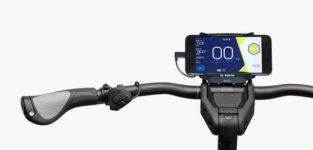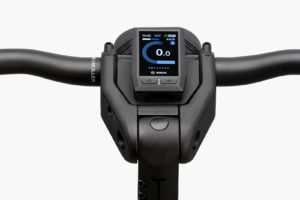1.0 How much does an e-bike cost?
This is really dependant on the quality and specification of a bike, but as an example, you can get a very basic bike fitted with a small battery and front hub motor for under £1,000.
However, I definitely wouldn’t be considering anything less than £3,000 and would want to have a mid-drive motor from one of the main manufacturers like Bosch, Yamaha, Specialized or Brose.
Riese & Muller manufacture premium electric bikes with Bosch motors and batteries along with high spec equipment like belt drives and internal Enviolo or Rohloff hubs.
Price range from £3,279 for a Swing up to £9,914 for a fully equipped, Superdelite GT with Rohloff E-14 electronic hub gears, 1125Wh Dualbattery, Gates Carbon belt drive, Sat Nav, Fox float suspension, etc….
Whilst there is no hiding the fact that a Riese & Müller Superdelite is not the cheapest bike on the market, remember people are investing in these as an alternative to a car as well as using them as a valuable tool for improving their physical and mental health.
2.0 How far will I get on one battery?
There are many things which will make a difference to the possible range on a single charge. These include;
- Type of motor (hub or mid-drive)
- Battery size (measured in Wh)
- Style of bike (trekking, mountain, city, touring etc)
- Weight of rider
- Temperature
- Transmission (Chain, belt, derailleur, hub gears)
- Terrain
- Level of assistance (eco, tour, sport or turbo)
It’s a big list but as a real-world example, I (weighing 90kgs) would expect a maximum of 65 miles from a single charge on a Riese & Muller Nevo touring with Bosch Performance CX motor and 500Wh battery, riding in Eco on country lanes around the Cotswold during the summer. And for the same as above but in turbo everywhere approximately 35 miles. And don’t forget, for all the uphill miles you have free downhill miles when you are travelling over 15.5 mph, which brings us nicely on to the next question…
3.0 How fast is an electric bike?
UK and EU law limits the assisted speed of an electric bike to 15.5 mph (25 km/h).
In practice on a Bosch motor, this means at 15.6 mph the assistance starts to fade and at 17.0 mph the motor cuts out completely. The good news is that you can still push the bike to travel faster than this. It can be difficult on the flat depending on the style of bike you have, but going downhill with the extra weight, acceleration to 40 mph is easily achievable. My fastest is 34.7mph on a Load 75 before I backed off!
4.0 How much does an electric bike weigh?
Again this depends on the type of bike you go for.
You can buy lightweight folding bikes or road bikes, but these both save significant kgs by reducing the size of the motor and battery.
Typically I would expect a well-equipped e-bike to upwards of 20kgs and in the case of something like the twin battery Superdelite GT Rohloff, more like 27 kgs. But don’t forget that whilst these numbers may seem high, they do include the weight of the mudguards, lights, transmission and racks.
And once you switch on the motor, the weight just melts away.
5.0 How long does it take to charge and how much does it cost?
Electric bikes usually have battery capacities ranging from 300 to 500Wh (Watt-hours) and this capacity combined with the size of the charger measured in Amps (A) will affect the time taken to fully charge a battery.
As an example, a 500Wh Bosch battery using the standard 4A charger will take approximately 3.5 hours to charge. However, the rate of charge is not linear, so the battery will charge rapidly for the first 80% and then slow for the last 20%.
The bosch chargers are available in three sizes 2A (compact), 4A (standard) and 6A (fast). But be aware the 6A charger is not backwardly compatible with older battery packs.
When it comes to cost, the average price paid for a kWh of electricity in the UK is around £0.14p, so a 500Wh (0.5kWh) battery would cost approximately £0.07p to fully charge.
Lastly, the practicality of charging a battery is pretty straightforward.
Every bike I have seen to date has had a removable battery which means it can be either charged on the bike or taken in the house to charge. All the chargers use a standard domestic 3 pin socket.
6.0 What is the most powerful and legal motor in the UK?
This will get confusing…
Power is measured in Watts (W) and in the UK and EU the law states that electric bikes must not have a motor with greater than 250W of nominal power.
Therefore, any bike with over 250W of nominal power is not legal. (don’t get this confused with battery capacity measured in Wh’s which affects the range of the bike). So by default, all the main manufacturers of e-bike motors will make 250W motors, so don’t bother looking here to find the most powerful bikes.
What you actually need to consider is the torque measured in Newton-meters (Nm) and the peak power, again measured in Watts (W).
Peak power is not a number often quoted but it has been suggested that a motor like the Bosch Performance CX Gen4 has a peak power of around 600W. Whilst this is huge, it is also only temporary output and not continuous, or it would be illegal.
Probably the most important figure to look for if you are a power junkie is the torque. The latest Bosch motor previously mentioned has 85Nm of torque available, and with the correct transmission and road conditions that can give you a huge burst of power. Having said that, trying to use all that torque on a slippery surface will probably end up with you lying on your back.
You will find the latest Bosch Performance CX motor in Bikes like the Superdelite, Delite (and mountain variations), Homage, Supercharger and Charger3 and Nevo. It is also in the Load 60/75 cargo bikes but with a different software version.
7.0 How often will I need to replace the battery?
If you look after your battery reasonably well, you should get a lot of hassle-free years of riding. Nearly all batteries on e-bikes produced today are made with Lithium-Ion.
But it is worth checking the warranty offered by the battery manufacturer because if something should go wrong they can be costly to replace. As an example, a replacement Bosch battery can cost anywhere from £500 to £800 in the UK.
But don’t panic, unless you do something really silly to the battery, you should never need to replace it.
As an example, Bosch offers a 2 year or 500 charge cycle warranty on all the batteries they sell in the UK, after which time they guarantee the battery will still have at 60% of its original capacity.
So assuming you were to get 50 miles from each full charge of your battery, this means the Bosch warranty is good for 25,000 miles in the first two years.
That’s truly amazing!!
8.0 Do I need a license, insurance or registration to ride an electric bike?
No, no and no.
One of the greatest things about UK legal electric bikes is they are granted the same freedoms as a traditional bike. This means that so long as you are at least 14, there is no restriction on where you use your bike beyond that of any other bike.
Unlike electric scooters, you can ride your electric bike on any UK road or bridleway. There is no need to get a new category on your driving license, no need to pay vehicle excise duty (VED) and no need to register with DVLA.
It’s almost too good to be true, and this is why I am a real advocate of sticking within the law, so we don’t lose these incredible freedoms.
If you are thinking of going for a non-UK legal bike, maybe with a twist throttle, more power or faster, don’t waste your money on modifying a once legal bike, just buy an electric motorbike. At least this way, you will be guided within the law ensuring you get many years of enjoyment from your purchase.
But remember, there are many more restrictions on where you can ride, and the cost will increase due to VED, registration and insurance.
9.0 Hub motor or mid-drive motor?
There are two main ways of propelling an electric bike.
The first is a hub motor. This can be positioned in either the front or rear wheel. You will find the cheapest e-bikes on the market using a front hub motor normally coupled with a rear rack battery. This is essentially a retrofit kit for a traditional bike and is the simplest way to make an electric bike.
Powering the front wheel can be quite a strange sensation, especially when climbing hills on loose or wet surfaces when your weight is naturally over the rear wheel. You can find the slips when trying to drag you up the hill.
The best position for a hub motor is in the rear wheel. This gives a far more natural feel with the rear wheel pushing the bike forward and the weight of the rider ensuring better traction.
Whilst hub motors are a great and cost-effective solution, they do have a major downside, especially when riding around steep hills as we see in the Cotswolds.
The motors used will typically be 250W but there will be a lot less torque available at lower speeds due to the speed at which the motor is spinning.
Basically, the speed of the motor is relative to the speed of the bike. As the bike goes slower, the motor spins slower, and when the motor spins slower it provides less assistance. So in the real world, you will find the assistance from the bike is fine when riding on relatively flat journeys. But when you come to a big hill, the assistance falls rapidly.
And I have had to push this type of bike up hills around the Cotswolds. 🙁
By far the best way of powering an electric bike is with a mid-drive motor.
You will see all the major brands like Bosch, Yamaha, Shimano and Brose developing only this technology. With this type of technology, the motor is sitting between the pedal cranks in the place of the bottom bracket.
The biggest benefit here is the way we use a bike is to try and keep our legs spinning at the same speed (cadence) by changing gear. This benefits the motor as we are keeping the motor speed up and it is able to deliver more power even at low speeds.
I would strongly recommend trying a bike on the terrain you will be riding to ensure the technology is suitable for the use you intend, and whenever possible, go for the mid-motor option even if you have to compromise on the overall specification of the bike.
10.0 Are they expensive to maintain?
The maintenance of an e-bike is very similar in both price and complexity to a traditional bike.
Things can get more complicated with replacing a belt-drive, but don’t forget the preventative maintenance is significantly reduced due to the lack of cleaning and oiling required.
The major costs you are likely to face are replacement, brake pads, chains, tyres and inner tubes.
All this maintenance can be completed by a competent home mechanic (or even a happy bodger!), at very little cost. As a guide, an inner tube will cost £5-£15, a tyre £40-£80, a chain £15-£50, brake pads £5-£20.
And as a comparison to the maintenance of a car, the cost is insignificant.















